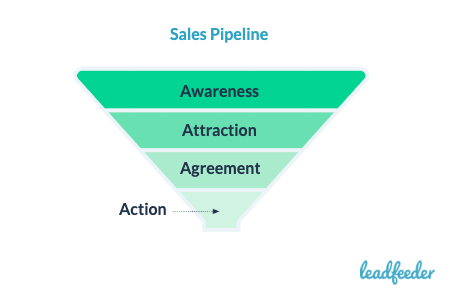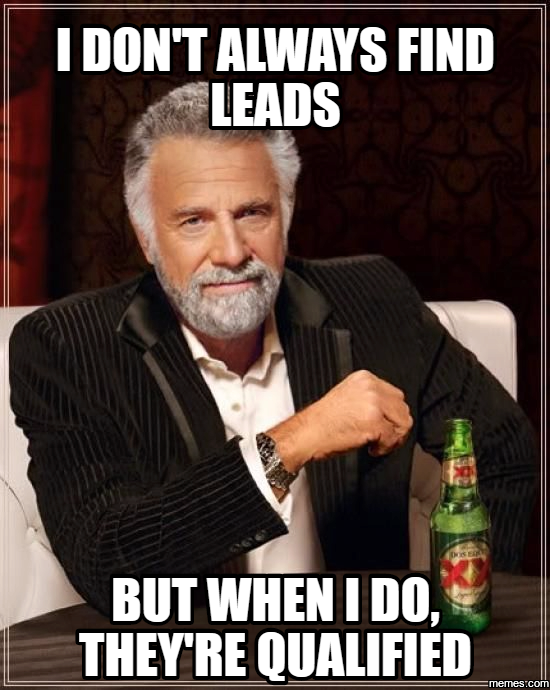I really hate that scene in Glengarry Glen Ross.
You know the one:
Partially because the grammar is off, and partially because it's convinced a lot of salespeople that being annoying is a good sales strategy.
No one wants someone sliding into their LinkedIn DMs with no clue what they actually need — or even their job title.
At Leadfeeder, we understand that sales is (and always has been) a process.
Sometimes it's a really slow process of moving prospects from attraction, to agreement, to action.

Even if you are starting from scratch, you don’t have to put in hundreds of hours of work to grow your business. One of the most efficient tools to build a reliable revenue stream is a sales pipeline.
And I am going to walk you through how to create one that is scalable.
Note: Want to see which companies surfing your site? Sign up for Leadfeeder’s free 14-day trial to track and monitor the information and behavior of your leads.
Why is a sales pipeline important?
The sales pipeline provides a visual representation of a company's sales process. This can help highlight opportunities for growth and make it easier to find (and fix) leaks in the pipeline.
A well-defined sales pipeline tells sales reps what step comes next, making their jobs easier and their work day far more effective.
Sales pipelines also provide leaders with the information they need to forecast revenue, plan for long-term growth, and take strategic actions.
How to build a sales pipeline
Step 1: Research your audience
Who is your audience? Even if your business targets a large audience, there are specific traits they all share.
It is important to go beyond standard demographics — thirty-year-old tech workers who make between 80 and 90K annually, for example.
Dig deep to understand what challenges and pain points your audience faces and how you can help.
Understanding what drives them to take each step makes your sales pipeline easier to complete, and more effective.
Here's the issue — a lot of companies think they know who their audience is. But they rely on gut instinct rather than data.
Major mistake.
So, where do you find the data? Here are a few places to start:
Your CRM: What traits do your most profitable current customers face?
Google Analytics: Enable the Demographics and Interests report and use that data to understand who visits your website.
Customer service agents: What do customers struggle with? What solutions are they looking for? Customer service agents talk to customers every day and can provide insights you won't find anywhere else.
Customer surveys: Perform an annual survey to ask customers who they are and what challenges they face. This can help improve sales and marketing efforts and provide information for product development.
Social media insights: Facebook, Instagram, LinkedIn, and most other social platforms provide audience insights, including interests, and demographics.
Knowing the answers to these questions will make it easier for you to find your audience, address their pains effectively, and position your brand in a unique way.
Step 2: Create buyer personas
I know, I know, buyer personas can feel a little lame.
But they matter. In the research stage you gathered a bunch of data — but what does that data actually mean? How will it impact your sales pipeline?
Without a buyer persona, your audience research is relegated to spreadsheets — which isn't super helpful when deciding what landing page design to use or what blog post to write.
Based on what your customers want from your product and how they use it, you can group them into a persona that represents these features. For example, say a portion of your audience is working mothers in their thirties, who want to waste as little time as possible making decisions but want to feel in control.
To create a more personalized and enjoyable experience for them, your buyer persona might be a fictional woman, Tracy, 34, mother of two who works in HR for a financial institution. You can then craft a detailed sales journey for her. Does she find out about your product or service on Facebook, LinkedIn, or at industry conferences?
What information does she need to make a purchase decision? Who else will she consult before making a purchase? Is she the final decision maker? What type of content is she likely to consume?
The answers to these questions will guide each step of your sales pipeline.
Make sure to create a buyer persona for each main group in your audience and use them to guide you.
Step 3: Find those leads
You know who your audience is. You understand what drives them, and you have a buyer persona to serve as a litmus test for your sales funnel.
Now it is time to start driving leads. There's no one right way to drive leads — your industry and audience should be your guide here.
For example, if your audience spends a lot of time researching on LinkedIn, then that might be the way to go.
Here are a few other ways to drive leads:
Lead magnets: Offer a downloadable guide, ebook, template, or worksheets to draw in potential customers. For example, at Leadfeeder, we’re offering this sales ebook.
Guest post on industry sites: Share your expertise on popular industry sites. Prospects will begin to trust you and are likely to follow up with your solution.
Social media: Social might feel weird for lead generation in B2B — but Facebook, Twitter, and LinkedIn have massive reach. Giveaways and webinars can drive quality leads, even for B2B.
Offer a free tool: Can you create a free tool (or a limited free plan) to solve a problem your audience faces? For example, MailChimp offers a free limited plan for their email and CRM tool. Customers can try the software before they buy.
Your website traffic: Who visits your website but doesn't leave their contact info? Our website tracking tool helps businesses track uncover anonymous site visitors so you can
Don’t forget about organic search traffic – optimize your site and make sure that people who look for your solution can find you.
Step 4: Sort qualified and unqualified leads
By this step, you should have a solid list of leads in your target audience.
But, there's an issue: not all those leads are ready to buy. Some people might still be in the awareness stage; others might be comparing their options but aren't quite ready to buy.
The problem is if you send all your leads to sales at this stage, they're going to waste a bunch of time chasing down prospects who aren't ready to buy.
Instead of frustrating your sales team, make sure to qualify leads and separate the ones that aren't quite to the conversion stage yet.

How you separate leads will depend on your specific audience and your industry. However, here are a few good indications they are ready to convert:
They've visited several pages on your website, including your pricing or services page.
They've downloaded/signed up for a lead magnet.
They are reading comparison pages.
Leads that are ready to buy should be contacted quickly, everyone else should move on to the engagement step.
Step 5: Build engagement
Now, it’s time to entertain your leads in the pipeline – and at this stage content is king.
Video tutorials, reviews, guides, useful blog posts, case studies, infographics – anything that is engaging for your customers. The key is to produce useful, engaging content regularly and promote it on social media, etc. for a wider reach.
You should already know what type of content will work the best (from your research stage).
Now produce that content, start sharing, and don't forget to use A/B testing to determine what content and format your audience responds best to.
P.S. - If video is involved in your content strategy, watch this webinar on using video to accelerate your pipeline.
Step 6: Convert
Your audience is educated and has developed sufficient interest in your product or service. They need just one final push in the right direction.
You've done most of the hard work, but you don't want to lose the sale this late in the game. Here are a few ways to ensure your hard work pays off:
Keep your sales page simple: Remove any clutter that may distract your customer. Ideally, there should be no more than three key features.
Use video: Wrap up the benefits or offer with a personalized video that shows your sales team is paying attention to what the prospects actually need.
Test offering two CTAs: Offer one button that leads to a check out (Buy now/Subscribe/Choose a plan) and another CTA for customers who are still hesitant (Learn more/Start a trial/Sign up for free/Claim a discount) so you can follow up later.
Make it easy to convert: Keep pricing transparent, don't make them fill out a 25-page questionnaire to get started. Make it easy for them to hand over their hard-earned cash.
Step 7: Make your sales pipeline scalable
You made it. By now, you should have at least a handful of customers — go you.
Now it's time to make sure you can repeat this process over and over again to keep new leads coming in.
Start by testing each step of the sales pipeline. You might find that prospects you thought were unqualified just need a bit more education to convert.
Consider using automation to take over tedious tasks like data entry, email follow-ups, or sending leads to your sales team. This will give sales and marketing more time to focus on strategy.
Don’t forget to keep in touch with existing customers – ask for their feedback, offer a promo code for the next purchase, or just a “thank you” for choosing your company.
Final thoughts
The best way to turn prospects into customers is to listen to what they need. Take the time to understand the challenges they face and use that information to generate your sales pipeline.
Standard lead gen strategies like ebooks work, but don't underestimate lead generation tools like Leadfeeder that help businesses find less common leads.
Note: Want to see which companies visiting your website? Sign up for Leadfeeder’s free 14-day trial to track and monitor the information and behavior of your leads.
Now that you're here
Leadfeeder is a tool that shows you companies that visit your website. Leadfeeder generates new leads, offers insight on your customers and can help you increase your marketing ROI.
If you liked this blog post, you'll probably love Leadfeeder, too.
Sign up





